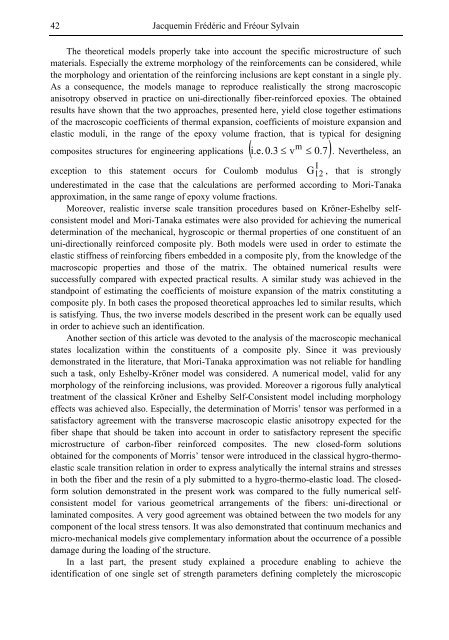Composite Materials Research Progress
Composite Materials Research Progress
Composite Materials Research Progress
Create successful ePaper yourself
Turn your PDF publications into a flip-book with our unique Google optimized e-Paper software.
42<br />
Jacquemin Frédéric and Fréour Sylvain<br />
The theoretical models properly take into account the specific microstructure of such<br />
materials. Especially the extreme morphology of the reinforcements can be considered, while<br />
the morphology and orientation of the reinforcing inclusions are kept constant in a single ply.<br />
As a consequence, the models manage to reproduce realistically the strong macroscopic<br />
anisotropy observed in practice on uni-directionally fiber-reinforced epoxies. The obtained<br />
results have shown that the two approaches, presented here, yield close together estimations<br />
of the macroscopic coefficients of thermal expansion, coefficients of moisture expansion and<br />
elastic moduli, in the range of the epoxy volume fraction, that is typical for designing<br />
m<br />
composites structures for engineering applications ( i.e. 0.3 ≤ v ≤ 0.7)<br />
. Nevertheless, an<br />
I<br />
exception to this statement occurs for Coulomb modulus G 12 , that is strongly<br />
underestimated in the case that the calculations are performed according to Mori-Tanaka<br />
approximation, in the same range of epoxy volume fractions.<br />
Moreover, realistic inverse scale transition procedures based on Kröner-Eshelby selfconsistent<br />
model and Mori-Tanaka estimates were also provided for achieving the numerical<br />
determination of the mechanical, hygroscopic or thermal properties of one constituent of an<br />
uni-directionally reinforced composite ply. Both models were used in order to estimate the<br />
elastic stiffness of reinforcing fibers embedded in a composite ply, from the knowledge of the<br />
macroscopic properties and those of the matrix. The obtained numerical results were<br />
successfully compared with expected practical results. A similar study was achieved in the<br />
standpoint of estimating the coefficients of moisture expansion of the matrix constituting a<br />
composite ply. In both cases the proposed theoretical approaches led to similar results, which<br />
is satisfying. Thus, the two inverse models described in the present work can be equally used<br />
in order to achieve such an identification.<br />
Another section of this article was devoted to the analysis of the macroscopic mechanical<br />
states localization within the constituents of a composite ply. Since it was previously<br />
demonstrated in the literature, that Mori-Tanaka approximation was not reliable for handling<br />
such a task, only Eshelby-Kröner model was considered. A numerical model, valid for any<br />
morphology of the reinforcing inclusions, was provided. Moreover a rigorous fully analytical<br />
treatment of the classical Kröner and Eshelby Self-Consistent model including morphology<br />
effects was achieved also. Especially, the determination of Morris’ tensor was performed in a<br />
satisfactory agreement with the transverse macroscopic elastic anisotropy expected for the<br />
fiber shape that should be taken into account in order to satisfactory represent the specific<br />
microstructure of carbon-fiber reinforced composites. The new closed-form solutions<br />
obtained for the components of Morris’ tensor were introduced in the classical hygro-thermoelastic<br />
scale transition relation in order to express analytically the internal strains and stresses<br />
in both the fiber and the resin of a ply submitted to a hygro-thermo-elastic load. The closedform<br />
solution demonstrated in the present work was compared to the fully numerical selfconsistent<br />
model for various geometrical arrangements of the fibers: uni-directional or<br />
laminated composites. A very good agreement was obtained between the two models for any<br />
component of the local stress tensors. It was also demonstrated that continuum mechanics and<br />
micro-mechanical models give complementary information about the occurrence of a possible<br />
damage during the loading of the structure.<br />
In a last part, the present study explained a procedure enabling to achieve the<br />
identification of one single set of strength parameters defining completely the microscopic
















